The second full length animated Disney classic, Pinocchio (Hamilton Luske, Ben Sharpsteen, a.o., 1940), is based on the 19th century Italian novel of the same name by Carlo Collodi. It's a gem. For this post we found some wonderful vintage postcards from The Netherlands, published by Rembrandt Uitgeversmaatschappij in Amsterdam. We added French vintage cards by Editions E. Séphériadès and Editions Superluxe, and a more recent French postcard.
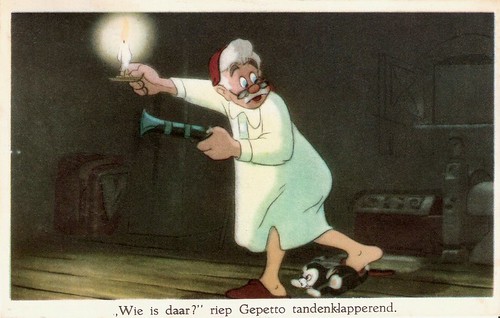
Dutch postcard by Rembrandt Uitg. Mij, Amsterdam. Image: Walt Disney. Publicity still for Pinocchio (Hamilton Luske, Ben Sharpsteen, a.o., 1940). Caption: "Who is there?", Gepetto called with shattering teeth.

Dutch postcard by Rembrandt Uitg. Mij, Amsterdam. Image: Walt Disney. Publicity still for Pinocchio (Hamilton Luske, Ben Sharpsteen, a.o., 1940). Caption: And Pinocchio danced on stage with the Dutch marionette girls...

Dutch postcard by Rembrandt Uitg. Mij, Amsterdam. Image: Walt Disney. Publicity still for Pinocchio (Hamilton Luske, Ben Sharpsteen, a.o., 1940). Caption: Lampwick, the britterchopper lit a cigar when he went playing billiards.

Dutch postcard by Rembrandt Uitg. Mij, Amsterdam. Image: Walt Disney. Publicity still for Pinocchio (Hamilton Luske, Ben Sharpsteen, a.o., 1940). Caption: Pinocchio felt something terrible .... two long ears and a tail!

French postcard by Editions Kroma, Caissargues, no. 10. Image: Walt Disney Productions. Publicity still for Pinocchio (Hamilton Luske, Ben Sharpsteen, a.o., 1940).
In Pinocchio (Hamilton Luske, Ben Sharpsteen, a.o., 1940), the kind woodcarver Geppetto creates a wooden marionette, which he calls Pinocchio.
His wish for Pinocchio to be a real boy is unexpectedly granted by a fairy. The fairy assigns Jiminy Cricket to act as Pinocchio's 'conscience' and keep him out of trouble.
However, Pinocchio is weak-willed and Jiminy is not too successful in his endeavour. Pinocchio doesn't always listen to reason and most of the film he is deep in trouble.
The story has never a dull moment. In fact Pinocchio is about childhood and temptation. Tasting jam, stealing, not going to school, lying, childhood is full of temptations. Everything is new then everything looks pretty.
When the standard for kids is to obey to authoritarian figures who know the best for them, the most precious lesson in Pinocchio is not to obey for the sake of obedience but to follow your conscience. Differentiate between right or wrong. That's what being a real boy is about, being unselfish, trustful and brave, not being obedient.

French postcard by Editions E. Séphériadès, Paris, no. 1. Image: Walt Disney - Mickey Mouse S.A. Publicity still for Pinocchio (Hamilton Luske, Ben Sharpsteen, a.o., 1940). Caption: The olf wood sculptor Gepetto wishes that the puppet he made, comes to life.

French postcard by Editions E. Séphériadès, Paris, no. 2. Image: Walt Disney - Mickey Mouse S.A. Publicity still for Pinocchio (Hamilton Luske, Ben Sharpsteen, a.o., 1940). Caption: The Blue Fairy comes during the night, to fulfil the wish of Gepetto.
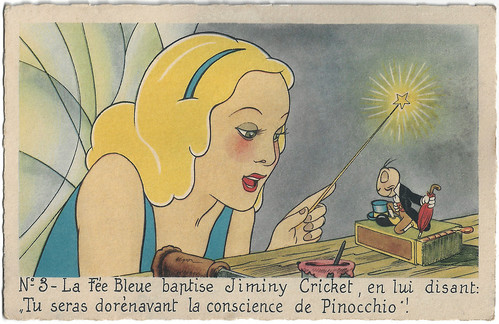
French postcard by Editions E. Séphériadès, Paris, no. 3. Image: Walt Disney - Mickey Mouse S.A. Publicity still for Pinocchio (Hamilton Luske, Ben Sharpsteen, a.o., 1940). Caption: The Blue Fairy baptises Jiminy Cricket, by telling him: "You will be from now on Pinocchio's conscience."
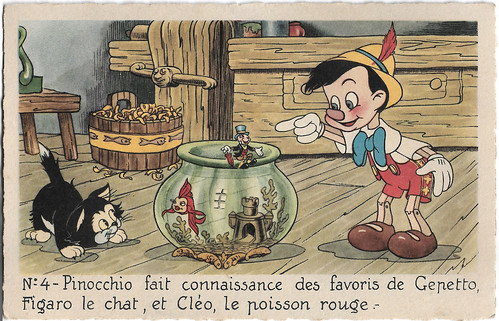
French postcard by Editions E. Séphériadès, Paris, no. 4. Image: Walt Disney - Mickey Mouse S.A. Publicity still for Pinocchio (Hamilton Luske, Ben Sharpsteen, a.o., 1940). Caption: Pinocchio meets Gepetto's favourites, Figaro the cat and Cléo the goldfish.
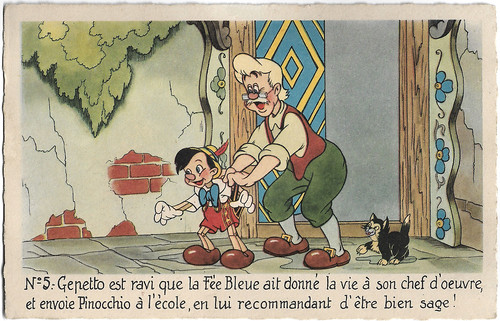
French postcard by Editions E. Séphériadès, Paris, no. 5. Image: Walt Disney - Mickey Mouse S.A. Publicity still for Pinocchio (Hamilton Luske, Ben Sharpsteen, a.o., 1940). Caption: Gepetto is delighted that the Blue Fairy has given life to his masterpiece and sends Pinocchio to school, recommending him to be wise.
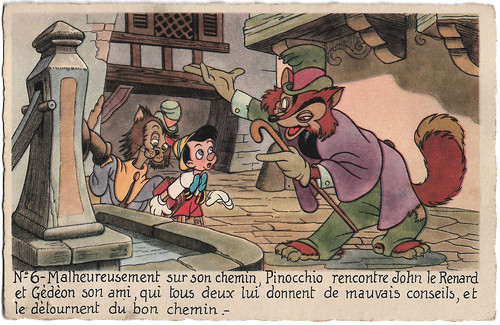
French postcard by Editions Superluxe, Paris, no. 5. Image: Walt Disney - Mickey Mouse S.A. Publicity still for Pinocchio (Hamilton Luske, Ben Sharpsteen, a.o., 1940). Caption: Unfortunately, Pinocchio meets on his way John the Fox and Gèdèon his friend, both of whom give him bad advice, and divert him from the right path.
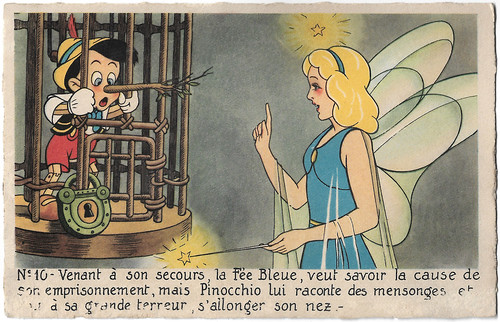
French postcard by Editions E. Séphériadès, Paris, no. 10. Image: Walt Disney - Mickey Mouse S.A. Publicity still for Pinocchio (Hamilton Luske, Ben Sharpsteen, a.o., 1940). Caption: Coming to his aid, the Blue Fairy wants to know the cause of his imprisonment, but Pinocchio tells her lies and to his great terror, she lengthens his nose.
Although the atmosphere is quite dark and creepy in some parts, most of the time Pinocchio (Hamilton Luske, Ben Sharpsteen, a.o., 1940) is a sweet fairy-tale. It is entertaining, heartwarming and magical.
Animation and soundtrack are superb. Walt Disney made Pinocchio shortly after Snow White and the Seven Dwarfs (William Cottrell, David Hand, a.o., 1937), and the film showed marked improvement in the art of animation technology with startling special effects. The animation makes brilliant use of the multiplane camera, featuring a sprawling opening sequence in which the viewer practically sees the entire village at night.
Geppetto's inventive clocks come to life as realistically as any real-life photography could do. The scene of Geppetto searching for Pinocchio with a lantern on a rainy night after he has been captured by Stromboli is unforgettable imagery.
The characters are colourful and fun. Pinocchio is cute, innocent and lovable like a human child, although stubborn and prone to temptation at times. Jiminy Cricket is humorous and cool, but a bit impatient.
Pinocchio is full of sweet characters like Geppetto's goldfish Cleo and kitten Figaro. Honest John Foulfellow and his sidekick Gideon aka 'Giddy' are the perfect comic relief. Giddy is a cat and a funny mute character. Honest John is the epitome of the sly fox: not 'really' evil, but clever, hilarious, charming, shameless, unscrupulous and greedy. And Monstro, the enormous sperm whale, is one of the most impressive animated beasts of all time.

French postcard by Editions E. Séphériadès, Paris, no. 11. Image: Walt Disney - Mickey Mouse S.A. Publicity still for Pinocchio (Hamilton Luske, Ben Sharpsteen, a.o., 1940). Caption: The more Pinocchio lies, the longer his nose gets, and Jiminy Cricket adjures him to tell the truth.

French postcard by Editions Superluxe, Paris, no. 12. Image: Walt Disney - Mickey Mouse S.A. Publicity still for Pinocchio (Hamilton Luske, Ben Sharpsteen, a.o., 1940). Caption: Pinocchio has finally decided to tell the truth, and not to start again. His nose becomes normal again and the Blue Fairy sets him free.

French postcard by Editions Superluxe, Paris, no. 13. Image: Walt Disney - Mickey Mouse S.A. Publicity still for Pinocchio (Hamilton Luske, Ben Sharpsteen, a.o., 1940). Caption: Rescued Pinocchio, accompanied by Jiminy Cricket, runs to his father's house.
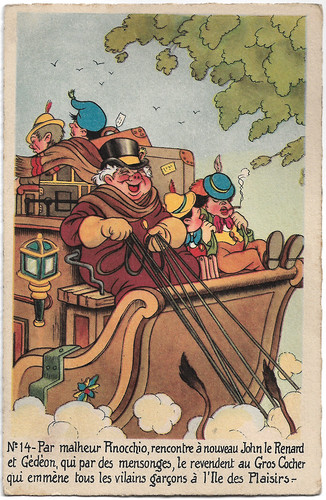
French postcard by Editions Superluxe, Paris, no. 14. Image: Walt Disney - Mickey Mouse S.A. Publicity still for Pinocchio (Hamilton Luske, Ben Sharpsteen, a.o., 1940). Caption: Unfortunately Pinocchio meets John the Fox and Gideon again, who by lies, sell him to the Big Coach who takes all the naughty boys to the Island of Pleasures.

French postcard by Editions E. Séphériadès, Paris, no. 15. Image: Walt Disney - Mickey Mouse S.A. Publicity still for Pinocchio (Hamilton Luske, Ben Sharpsteen, a.o., 1940). Caption: At the Island of Pleasures, Pinocchio with his new friend Lampwick, tastes of all the amusements, and does not want to listen to the advice of Jiminy Cricket.

French postcard by Editions E. Séphériadès, Paris, no. 16. Image: Walt Disney - Mickey Mouse S.A. Publicity still for Pinocchio (Hamilton Luske, Ben Sharpsteen, a.o., 1940). Caption: The bad boy Lampwick has changed into an ass, to the stupefaction of Pinocchio, who persists in not listening to the good advice by his conscience Jiminy Cricket.

French postcard by Editions Superluxe, Paris, no. 17. Image: Walt Disney - Mickey Mouse S.A. Publicity still for Pinocchio (Hamilton Luske, Ben Sharpsteen, a.o., 1940). Caption: Having managed to escape from Pleasure Island, Pinocchio and Jiminy cricket finally return home, where they find the door closed and his father away looking for him.

French postcard by Editions E. Séphériadès, Paris, no. 18. Image: Walt Disney - Mickey Mouse S.A. Publicity still for Pinocchio (Hamilton Luske, Ben Sharpsteen, a.o., 1940). Caption: Wanting to find his father Gepetto, swallowed by the Whale when he was looking for him, Pinocchio attaches a stone to the end of the tail, and plunges to the bottom of the sea.

French postcard by Editions E. Séphériadès, Paris, no. 20. Image: Walt Disney - Mickey Mouse S.A. Publicity still for Pinocchio (Hamilton Luske, Ben Sharpsteen, a.o., 1940). Caption: Pinocchio has the joy of finding his father Gepetto alive in the belly of the monster.

French postcard by Editions E. Séphériadès, Paris, no. 21. Image: Walt Disney - Mickey Mouse S.A. Publicity still for Pinocchio (Hamilton Luske, Ben Sharpsteen, a.o., 1940). Caption: At the bewilderment of Gepetto, Pinocchio shows him that he has ears and a donkey tail, by his disobedience.
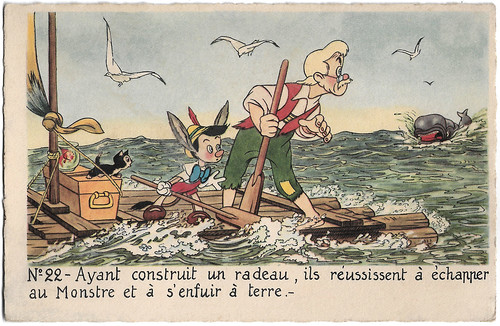
French postcard by Editions E. Séphériadès, Paris, no. 22. Image: Walt Disney - Mickey Mouse S.A. Publicity still for Pinocchio (Hamilton Luske, Ben Sharpsteen, a.o., 1940). Caption: Having built a raft, they managed to escape the monster and to flee to the land.

French postcard by Editions E. Séphériadès, Paris, no. 23. Image: Walt Disney - Mickey Mouse S.A. Publicity still for Pinocchio (Hamilton Luske, Ben Sharpsteen, a.o., 1940). Caption: The raft having capsized, they fail on the ground, half drowned; Gepetto believing dead Pinocchio, prays and implores the Blue Fairy.

Italian postcard by Grafiche Biondetti, Verona, no. 115/2. Image: Disney. Publicity still for Pinocchio (Hamilton Luske, Ben Sharpsteen, a.o., 1940).
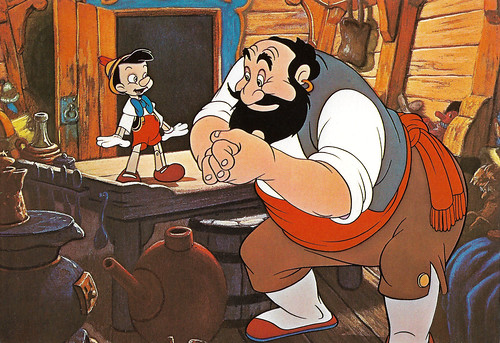
Italian postcard by Grafiche Biondetti, Verona, no. 115/3. Image: Disney. Publicity still for Pinocchio (Hamilton Luske, Ben Sharpsteen, a.o., 1940).

Italian postcard by Grafiche Biondetti, Verona, no. 115/4. Image: Disney. Publicity still for Pinocchio (Hamilton Luske, Ben Sharpsteen, a.o., 1940).
Sources: Wikipedia and IMDb.

Dutch postcard by Rembrandt Uitg. Mij, Amsterdam. Image: Walt Disney. Publicity still for Pinocchio (Hamilton Luske, Ben Sharpsteen, a.o., 1940). Caption: "Who is there?", Gepetto called with shattering teeth.

Dutch postcard by Rembrandt Uitg. Mij, Amsterdam. Image: Walt Disney. Publicity still for Pinocchio (Hamilton Luske, Ben Sharpsteen, a.o., 1940). Caption: And Pinocchio danced on stage with the Dutch marionette girls...

Dutch postcard by Rembrandt Uitg. Mij, Amsterdam. Image: Walt Disney. Publicity still for Pinocchio (Hamilton Luske, Ben Sharpsteen, a.o., 1940). Caption: Lampwick, the britterchopper lit a cigar when he went playing billiards.

Dutch postcard by Rembrandt Uitg. Mij, Amsterdam. Image: Walt Disney. Publicity still for Pinocchio (Hamilton Luske, Ben Sharpsteen, a.o., 1940). Caption: Pinocchio felt something terrible .... two long ears and a tail!

French postcard by Editions Kroma, Caissargues, no. 10. Image: Walt Disney Productions. Publicity still for Pinocchio (Hamilton Luske, Ben Sharpsteen, a.o., 1940).
Childhood is full of temptations
In Pinocchio (Hamilton Luske, Ben Sharpsteen, a.o., 1940), the kind woodcarver Geppetto creates a wooden marionette, which he calls Pinocchio.
His wish for Pinocchio to be a real boy is unexpectedly granted by a fairy. The fairy assigns Jiminy Cricket to act as Pinocchio's 'conscience' and keep him out of trouble.
However, Pinocchio is weak-willed and Jiminy is not too successful in his endeavour. Pinocchio doesn't always listen to reason and most of the film he is deep in trouble.
The story has never a dull moment. In fact Pinocchio is about childhood and temptation. Tasting jam, stealing, not going to school, lying, childhood is full of temptations. Everything is new then everything looks pretty.
When the standard for kids is to obey to authoritarian figures who know the best for them, the most precious lesson in Pinocchio is not to obey for the sake of obedience but to follow your conscience. Differentiate between right or wrong. That's what being a real boy is about, being unselfish, trustful and brave, not being obedient.

French postcard by Editions E. Séphériadès, Paris, no. 1. Image: Walt Disney - Mickey Mouse S.A. Publicity still for Pinocchio (Hamilton Luske, Ben Sharpsteen, a.o., 1940). Caption: The olf wood sculptor Gepetto wishes that the puppet he made, comes to life.

French postcard by Editions E. Séphériadès, Paris, no. 2. Image: Walt Disney - Mickey Mouse S.A. Publicity still for Pinocchio (Hamilton Luske, Ben Sharpsteen, a.o., 1940). Caption: The Blue Fairy comes during the night, to fulfil the wish of Gepetto.

French postcard by Editions E. Séphériadès, Paris, no. 3. Image: Walt Disney - Mickey Mouse S.A. Publicity still for Pinocchio (Hamilton Luske, Ben Sharpsteen, a.o., 1940). Caption: The Blue Fairy baptises Jiminy Cricket, by telling him: "You will be from now on Pinocchio's conscience."

French postcard by Editions E. Séphériadès, Paris, no. 4. Image: Walt Disney - Mickey Mouse S.A. Publicity still for Pinocchio (Hamilton Luske, Ben Sharpsteen, a.o., 1940). Caption: Pinocchio meets Gepetto's favourites, Figaro the cat and Cléo the goldfish.

French postcard by Editions E. Séphériadès, Paris, no. 5. Image: Walt Disney - Mickey Mouse S.A. Publicity still for Pinocchio (Hamilton Luske, Ben Sharpsteen, a.o., 1940). Caption: Gepetto is delighted that the Blue Fairy has given life to his masterpiece and sends Pinocchio to school, recommending him to be wise.

French postcard by Editions Superluxe, Paris, no. 5. Image: Walt Disney - Mickey Mouse S.A. Publicity still for Pinocchio (Hamilton Luske, Ben Sharpsteen, a.o., 1940). Caption: Unfortunately, Pinocchio meets on his way John the Fox and Gèdèon his friend, both of whom give him bad advice, and divert him from the right path.

French postcard by Editions E. Séphériadès, Paris, no. 10. Image: Walt Disney - Mickey Mouse S.A. Publicity still for Pinocchio (Hamilton Luske, Ben Sharpsteen, a.o., 1940). Caption: Coming to his aid, the Blue Fairy wants to know the cause of his imprisonment, but Pinocchio tells her lies and to his great terror, she lengthens his nose.
Unforgettable imagery
Although the atmosphere is quite dark and creepy in some parts, most of the time Pinocchio (Hamilton Luske, Ben Sharpsteen, a.o., 1940) is a sweet fairy-tale. It is entertaining, heartwarming and magical.
Animation and soundtrack are superb. Walt Disney made Pinocchio shortly after Snow White and the Seven Dwarfs (William Cottrell, David Hand, a.o., 1937), and the film showed marked improvement in the art of animation technology with startling special effects. The animation makes brilliant use of the multiplane camera, featuring a sprawling opening sequence in which the viewer practically sees the entire village at night.
Geppetto's inventive clocks come to life as realistically as any real-life photography could do. The scene of Geppetto searching for Pinocchio with a lantern on a rainy night after he has been captured by Stromboli is unforgettable imagery.
The characters are colourful and fun. Pinocchio is cute, innocent and lovable like a human child, although stubborn and prone to temptation at times. Jiminy Cricket is humorous and cool, but a bit impatient.
Pinocchio is full of sweet characters like Geppetto's goldfish Cleo and kitten Figaro. Honest John Foulfellow and his sidekick Gideon aka 'Giddy' are the perfect comic relief. Giddy is a cat and a funny mute character. Honest John is the epitome of the sly fox: not 'really' evil, but clever, hilarious, charming, shameless, unscrupulous and greedy. And Monstro, the enormous sperm whale, is one of the most impressive animated beasts of all time.

French postcard by Editions E. Séphériadès, Paris, no. 11. Image: Walt Disney - Mickey Mouse S.A. Publicity still for Pinocchio (Hamilton Luske, Ben Sharpsteen, a.o., 1940). Caption: The more Pinocchio lies, the longer his nose gets, and Jiminy Cricket adjures him to tell the truth.

French postcard by Editions Superluxe, Paris, no. 12. Image: Walt Disney - Mickey Mouse S.A. Publicity still for Pinocchio (Hamilton Luske, Ben Sharpsteen, a.o., 1940). Caption: Pinocchio has finally decided to tell the truth, and not to start again. His nose becomes normal again and the Blue Fairy sets him free.

French postcard by Editions Superluxe, Paris, no. 13. Image: Walt Disney - Mickey Mouse S.A. Publicity still for Pinocchio (Hamilton Luske, Ben Sharpsteen, a.o., 1940). Caption: Rescued Pinocchio, accompanied by Jiminy Cricket, runs to his father's house.

French postcard by Editions Superluxe, Paris, no. 14. Image: Walt Disney - Mickey Mouse S.A. Publicity still for Pinocchio (Hamilton Luske, Ben Sharpsteen, a.o., 1940). Caption: Unfortunately Pinocchio meets John the Fox and Gideon again, who by lies, sell him to the Big Coach who takes all the naughty boys to the Island of Pleasures.

French postcard by Editions E. Séphériadès, Paris, no. 15. Image: Walt Disney - Mickey Mouse S.A. Publicity still for Pinocchio (Hamilton Luske, Ben Sharpsteen, a.o., 1940). Caption: At the Island of Pleasures, Pinocchio with his new friend Lampwick, tastes of all the amusements, and does not want to listen to the advice of Jiminy Cricket.

French postcard by Editions E. Séphériadès, Paris, no. 16. Image: Walt Disney - Mickey Mouse S.A. Publicity still for Pinocchio (Hamilton Luske, Ben Sharpsteen, a.o., 1940). Caption: The bad boy Lampwick has changed into an ass, to the stupefaction of Pinocchio, who persists in not listening to the good advice by his conscience Jiminy Cricket.

French postcard by Editions Superluxe, Paris, no. 17. Image: Walt Disney - Mickey Mouse S.A. Publicity still for Pinocchio (Hamilton Luske, Ben Sharpsteen, a.o., 1940). Caption: Having managed to escape from Pleasure Island, Pinocchio and Jiminy cricket finally return home, where they find the door closed and his father away looking for him.

French postcard by Editions E. Séphériadès, Paris, no. 18. Image: Walt Disney - Mickey Mouse S.A. Publicity still for Pinocchio (Hamilton Luske, Ben Sharpsteen, a.o., 1940). Caption: Wanting to find his father Gepetto, swallowed by the Whale when he was looking for him, Pinocchio attaches a stone to the end of the tail, and plunges to the bottom of the sea.

French postcard by Editions E. Séphériadès, Paris, no. 20. Image: Walt Disney - Mickey Mouse S.A. Publicity still for Pinocchio (Hamilton Luske, Ben Sharpsteen, a.o., 1940). Caption: Pinocchio has the joy of finding his father Gepetto alive in the belly of the monster.

French postcard by Editions E. Séphériadès, Paris, no. 21. Image: Walt Disney - Mickey Mouse S.A. Publicity still for Pinocchio (Hamilton Luske, Ben Sharpsteen, a.o., 1940). Caption: At the bewilderment of Gepetto, Pinocchio shows him that he has ears and a donkey tail, by his disobedience.

French postcard by Editions E. Séphériadès, Paris, no. 22. Image: Walt Disney - Mickey Mouse S.A. Publicity still for Pinocchio (Hamilton Luske, Ben Sharpsteen, a.o., 1940). Caption: Having built a raft, they managed to escape the monster and to flee to the land.

French postcard by Editions E. Séphériadès, Paris, no. 23. Image: Walt Disney - Mickey Mouse S.A. Publicity still for Pinocchio (Hamilton Luske, Ben Sharpsteen, a.o., 1940). Caption: The raft having capsized, they fail on the ground, half drowned; Gepetto believing dead Pinocchio, prays and implores the Blue Fairy.

Italian postcard by Grafiche Biondetti, Verona, no. 115/2. Image: Disney. Publicity still for Pinocchio (Hamilton Luske, Ben Sharpsteen, a.o., 1940).

Italian postcard by Grafiche Biondetti, Verona, no. 115/3. Image: Disney. Publicity still for Pinocchio (Hamilton Luske, Ben Sharpsteen, a.o., 1940).

Italian postcard by Grafiche Biondetti, Verona, no. 115/4. Image: Disney. Publicity still for Pinocchio (Hamilton Luske, Ben Sharpsteen, a.o., 1940).
Sources: Wikipedia and IMDb.
Wonderful!
ReplyDelete